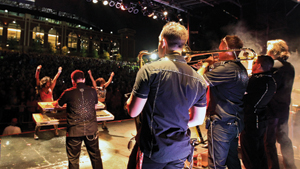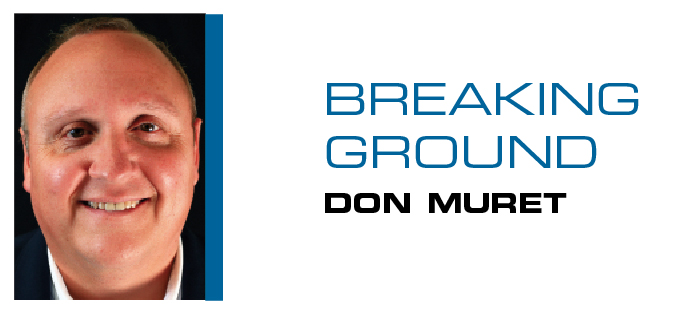The Texas Rangers have installed new audio technology at their ballpark that its inventor says could revolutionize the way sound is distributed for MLB games and dramatically improve the fan experience.
The product, Stadium Sound, is computer software developed by musician, producer and composer Paul Gilman. It is tied to a black box in the control room at Rangers Ballpark that reshapes sound waves and distributes them evenly throughout the facility.
In essence, the software acts as the audio system’s “brain” to intelligently transform sound before it is piped through the ballpark’s amplifiers and speakers, Gilman said. Current audio technology inside most stadiums has sound waves often “fighting each other” with choppy distribution to the seating bowl and adjustments made after the fact, he said. Repurposing sound through the new device on the front end ensures smoother distribution of sound. With the addition of the box in the control room, Gilman can monitor the ballpark’s audio system from his office in Los Angeles through an Ethernet connection to his home computer.
“One facility, one sound,” said Rob Matwick, the Rangers’ executive vice president of ballpark operations. “The difference has been amazing.”
 |
BRAD NEWTON / TEXAS RANGERS
The Rangers now hope to bring shows like KC and the Sunshine Band inside the ballpark. |
For the Rangers, installing Stadium Sound was a portion of the $800,000 overhaul of the park’s audio system before the 2011 season. Those upgrades could prompt the team to move a few postgame concerts, now held on the North Lawn outside the ballpark, inside the building. An act such as KC and the Sunshine Band, which performed April 24 in that space, could play inside the park and tap into the improved house system without having to bring in much of their own audio equipment, Matwick said.
The change in venue could save the Rangers money. They had to pay KC and the Sunshine Band $15,000 above its normal fees to cover enhanced sound production.
“We have been talking for a few years about the opportunity to do shows inside the park at the end of the game, and we can do it now,” Matwick said.
WHERE’S BIG RED?: Officials developing the new Haymarket Arena in Lincoln, Neb., started discussions last week over how the new $168 million home of Nebraska men’s basketball will be themed when it opens in the fall of 2013.
The building is publicly owned, and the city prefers to maintain the right mix of branding between Nebraska athletics, any potential naming-rights partner and other branding tied to its role as a multipurpose facility, said Paula Yancey, the facility’s program manager.
As of now, the plan is to have a big “N” installed on the arena exterior similar to Memorial Stadium on campus, and officials were to present options with a combination of red seats for the seating bowl and black seats for suites and possibly club seats. As of last week, the decisions on those seat colors had not been confirmed, Yancey said.
Otherwise, the arena won’t go heavy on the Huskers. In that respect, the building is a big departure from KFC Yum! Center in Louisville, the most recent project Yancey worked on for PC Sports, a firm that serves as an owner’s representative to develop sports facilities. That arena is red all over, reflecting the color scheme of the University of Louisville Cardinals, the primary tenant, and the marks of the food brands connected to the naming-rights holder.
In Lincoln, CSL Marketing has been hired to sell naming rights, founding partnerships and the 36 suites, 20 loge boxes and 900 club seats planned for the arena, whose name reflects the warehouse district where it will be built.
The University of Nebraska owns the advertising rights for the scoreboard and LED signs in the bowl for its basketball games.
DLR Group is the architect of record for the 16,000-seat arena.
ASSEMBLY LINE: The University of Illinois issued a proposal last month for an architect to design major improvements to 48-year-old Assembly Hall.
It’s a project the Big Ten school has kicked around for a decade as officials wavered between renovation and building a new arena.
The sports group at Aecom, formerly Ellerbe Becket, has completed three studies tied to Assembly Hall upgrades and will go after this job as well, said Brett Fuller, director of business development. Proposals are due Tuesday.�8;
Don Muret can be reached at dmuret@sportsbusinessjournal.com. Follow him on Twitter @BreakGround.





